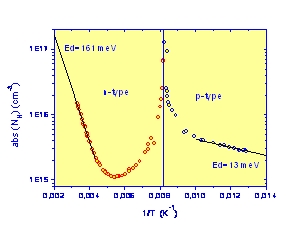Rechercher
Accueil > La Recherche > Axes & Equipes > Physique Appliquée > Transport Quantique & Nouveaux Systèmes 2D > Thème : Composants et Capteurs
InAs/GaSb superlattice for photodiodes
publié le
InAs/GaSb strain layer superlattices (SLS) emerge as an attractive system for infrared detection devices. Already the high performance photodiodes, in the 3-5 μm range (or MWIR : mid-wavelength infrared), and in the 8-12 μm (or LWIR : long wavelength infrared) atmospherics windows, comparable with state of the art HgCdTe technology have been demonstrated by some research groups. The material fabrication by molecular beam epitaxy is now quite mature, and simulation of the SLS band-gap has been achieved using different methods. Despite these impressive progresses, basic studies of the SLS material are still needed, in particular to get a better understanding of the carrier transport in such a structure. Our expertise in electrical measurements in extreme conditions (high pressure / high magnetic field) gives us a particularly useful tool for the study of multicarrier conduction in InAs/GaSb SLS case.

The analysis of some electrical transport results is based on Quantitative Spectrum Mobility Analysis (QSMA) method. The QSMA algorithm converts experimentally measured resistivity and Hall coefficient data into carrier mobility spectra in which the different type of carriers (heavy and light holes and electrons) could be identify as a taking part in the conduction process.
Collaboration/Contract : collaboration with IES from University of Montpellier 2








